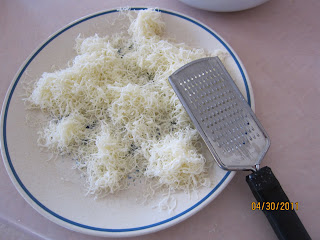Today was the beginning of Cyndy going out in our front yard each morning to pick fresh strawberries for her breakfast cereal.
She picks just enough for the days breakfast. They are much better than the large tasteless strawberries in the store.
Today Mr Nut made the Glazed all-beef Meatloaf that he made April 24, 2011 that was the basis for the blog of that day. This time the starting point was the pieces of round steak shown below.
Mr Nut thought it would be a good idea to make a very coarse grind of hamburger. Bad choice, the meat loaf did not hang together very well.
The rough ground hamburger. Along with some of the ingredients that need to be cooked and set aside until the loaf was to be formed.
This was one of the neat things about this recipe.
The Monterey Jack cheese was finely grated and then frozen, to be crumbled later and integrated into the loaf.
This was also a neat trick. Aluminum foil full of holes and set on a cooling rack to allow the grease to drain away from the loaf. Also, foil lined rimmed cookie sheet to catch the mess and avoid the clean up.
The loaf was ready for the heat (375℉).
All done time to cool and then dinner was served.
Recipe follows:
À bientôt,
Mr Nut
GLAZED ALL-BEEF MEATLOAF
Blog of April 30, 2011 revised Oct 31. 2011
From Cooks Illustrated Magazine
Published January 1, 2006.
Serves 6 to 8.
85 percent lean ground beef worked. Handle the meat gently; it should be thoroughly combined with other ingredients but not paste like. Glaze the loaf using the broiler. There are two applications of the glaze; increase cooking time for each by 2 to 3 minutes.
For meatloaf: 43.7 carbohydrates; 3,055.5 calories.
INGREDIENTS--Meatloaf
3 ounces (about 1 cup) grated Monterey Jack cheese. Carbs 0 g; Calories 330
1 tablespoon unsalted butter. Carbs 0 g: Calories 100
1 tablespoon unsalted butter. Carbs 0 g: Calories 100
1 medium onion, chopped fine (about 1 cup). Carbs 14 g: Calories 64
1 medium rib celery , chopped fine (about 1/2 cup, 120 g)). Carbs 2g: Calories 9
1/2 tsp minced garlic (2.5 g). Carbs 0 g: Calories 7
2 teaspoons minced fresh thyme leaves or 1 teaspoon dry thyme.
.
.
1 teaspoon paprika. Carbs 1.2 g ; Calories 6
1/4 cup tomato juice. Carbs 2.5 g: Calories 12.5
1/2 cup low-sodium chicken broth. Carbs 1 g; Calories 15
2 large eggs. Carbs 1 g; Calories 144
1/2 teaspoon unflavored gelatin (powdered).
1 tablespoon soy sauce. Carbs 2 g ; Calories 0
1 teaspoon Dijon mustard. Carbs 0 g; Calories 5
2/3 cup crushed saltine crackers. Carbs 22 g; Calories 120
2 tablespoons minced fresh parsley leaves or 2 teaspoons dry parsley flakes.
3/4 teaspoon Sea salt.
1/2 teaspoon ground black pepper.
2 pounds ground 85% or leaner ground beef. Carbs. 0 g; Calories 2244
INGREDIENTS-Glaze or just use a standard Barbecue sauce.
1/2 cup (4 ounces; 115 g ) KETCHUP. Carbs 35 g; Calories 140
1 teaspoon hot pepper sauce (TABASCO)
.
.
1/2 teaspoon ground coriander.
.
.
1/4 cup cider vinegar.
3 tablespoons (36 g; 1 1/4 ounce) packed light brown sugar. Carbs 36 g; Calories 135
INSTRUCTIONS
ABOUT One and a quarter hours BEFORE SERVING, adjust oven rack to
middle position; heat oven to 375 degrees.
middle position; heat oven to 375 degrees.
- Spread the finely grated cheese on plate and place in freezer until ready to use.
- Prepare baking sheet: Allowing meat loaf to stew in its own juices makes for a greasy mess. Try this: Fold heavy-duty aluminum foil to form a rectangle a little larger than your metal cooling rack. Center the foil on rack and place the rack in a rimmed baking sheet lined with aluminum foil (easy cleanup). Poke holes in the foil with a skewer (about half an inch apart). Spray the foil with nonstick cooking spray.
- Prepare the Blue ingredients; Onion and celery.
- Heat 1 tablespoon of butter in 10-inch skillet over medium-high heat until foaming; add blue ingredients and cook, stirring occasionally, until beginning to brown, 6 to 8 minutes.
- Add the green ingredients and cook, stirring, until fragrant, about 1 minute.
- Reduce heat to low and add 1/4 cup tomato juice. Cook, stirring to scrape up browned bits from pan, until thickened, about 1 minute. Transfer mixture to small bowl and set aside to cool.
- Whisk 1/2 cup chicken broth and the two eggs in large bowl until combined. Sprinkle 1/2 tsp gelatin over liquid and let stand 5 minutes.
- Stir in 1 tbs soy sauce, 1 tsp mustard, 2/3 cup saltines, 2 Tbs fresh parsley leaves (or 2 tsp parsley flakes), 3/4 tsp Sea salt, 2 tsp pepper, and onion/celery mixture.
- Crumble frozen cheese into coarse powder and sprinkle over mixture. Add ground beef; mix gently with hands until thoroughly combined.
- Transfer meat to the perforated foil rectangle on the cooling rack and shape into 10 by 6-inch oval about 2 inches high. Smooth top and edges of meatloaf with moistened spatula.
- Bake until an instant-read thermometer inserted into center of loaf reads 135 to 140 degrees, 55 to 65 minutes. Remove meatloaf from oven and turn on broiler.
- While meatloaf cooks, combine Red ingredients for glaze in small saucepan; bring to simmer over medium heat and cook, stirring, until thick and syrupy, about 5 minutes, or use commercial barbecue sauce. Spread half of glaze evenly over cooked meatloaf with rubber spatula; place under broiler and cook until glaze bubbles and begins to brown at edges, about 5 minutes. Remove meatloaf from oven and spread evenly with remaining glaze; place back under broiler and cook until glaze is again bubbling and beginning to brown, about 5 minutes more. Let meatloaf cool about 10 minutes before slicing.


























